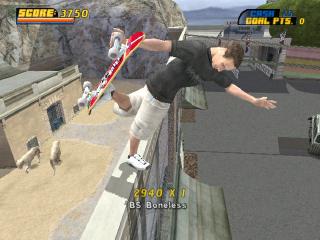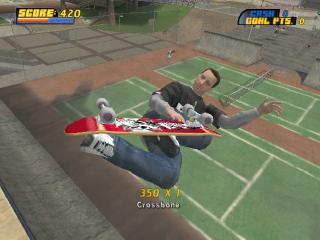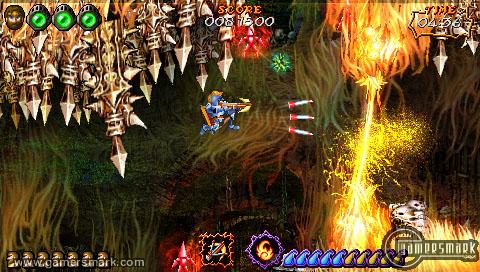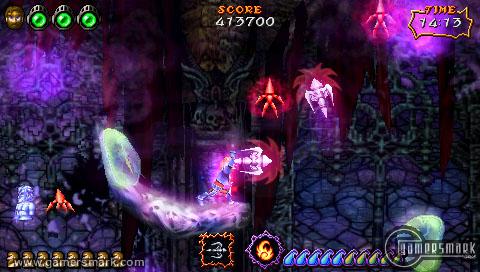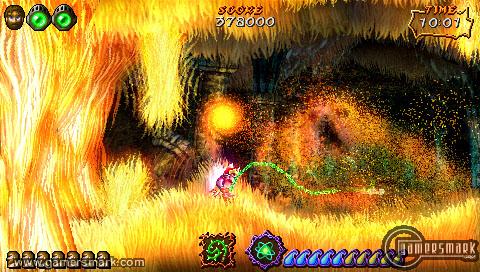Developer: Bandai Entertainment Company / Publisher: Namco Bandai Games || Overall: 3.5/10
I tend to stay away from bad games. It’s not that I have anything against them — it’s just that I’d rather not play them. Actually, let me take that back. When I happen upon a bad game, I take personal offense to it. Not only because of its lack of significance as a video game itself, but because I have to waste my precious time playing it in lieu of having better games to play instead. Eureka Seven Vol. 1: The New Wave is one such game. I literally became sick of playing. The amount of gameplay and story is ridiculously sloppy and unbalanced in its delivery. To complete the trinity, gameplay is horrid, and the story is appallingly boring. Based on the anime Eureka Seven, the game will most definitely fool its fans into possibly making a decision to play the game – a folly one at that.
Eureka Seven Vol. 1: The New Wave is lame. Super lame. There’s no way around it. It’s no joke when I say that this is a serious contender for worst game of the year. But besides all the daintiness associated with calling it the worst game ever without getting much more specific, there could be one or two redeeming qualities about the game. One is that I got to replace a broken case by switching the cover slip and manuals with Eureka Seven’s box, and the thought of the developers sitting in a room chortling over how they made the crappiest game possible out of a respectable anime’s IP.
Not having seen any of the anime, I took the dive into the game after playing another anime-based game, .hack//G.U. While I enjoyed .hack//G.U., which was from the Bandai side of Namco Bandai, I actually had some sparse hope that Eureka Seven would at least be on the same level. Unfortunately for me, that wasn’t the case. Eureka Seven Vol. 1: The New Wave is an action fighting mech game, not so different in concept from something like, say, Zone of the Enders. Except the mechs in Eureka Seven mainly just skate around on the floor and transform into vehicles. Don’t get the wrong impression when I make a parallel to ZOE, however; Eureka Seven Vol. 1: The New Wave quite literally blows in the gameplay department. There is nothing that makes you want to keep playing, as mediocrity spreads from your fingertips, up your arms and into your brain.
While the fighting can get somewhat hectic, and a more or less stable frame rate is apparent, you can’t get past the fact that what is happening during gameplay is that seemingly ice-skating robots are dancing around and smacking each other unrelentingly. With the occasional long range weapon being fired, the robotic combat is very uninteresting, to say the least. It doesn’t stop there, however. Things get from bad to worse, as there is even weaker “hand-to-hand” combat gameplay involved as well. Fighting in robots seems all too sleek when in comparison to this poorly construed concept tossed into the game. To make matters worse, there is also a crappy air-boarding sport called “lifting” that has the most wonky controls of all – not to mention it’s completely pointless in the grand scheme of the game.
There are two ways to play the game: a story mode and a “situation” mode. The story mode is the prequel to the start of the anime series and explains a little bit about the origins of all the main characters of the series and how they all came together, even if it is a bit sparse on the details and reasoning behind some of the events that actually happen. I wouldn’t be surprised if some of these reasonless plot directions are made just so that it could get in line with the actual storyline of the anime without wasting more time with actually explaining it, even if that is the point of the game from a story-based point of view. The other mode is called Situation, in which you are thrust into a predicament and you fight your way out, no story attached. Had the gameplay actually been interesting, this would be a worthy mode to have. But alas, it’s not.
My scathing disappointment mainly comes from the main mode, the story mode. The story mode is broken up into episodes, similar to how a television show would be; a series of events happen in a short period of time, and after the episode ends, a period of time passes before the next episode begins. This wouldn’t be so bad except for the fact that the opening theme and animation for the anime plays each time a new episode starts. I get it. I’m playing Eureka Seven — why do I have to see the same thing more than once? The story mode’s biggest fault comes when most of the actual game is spent watching cutscenes and dialogue scroll by. This. Is. Crap. Consistency also plays a part in it, since the cutscenes are voiced while most of the storyline dialogue that doesn’t take place in a cutscene is not. I say most, because randomly they will toss in some of the voice actors whenever they feel like it. I don’t understand why all the lines aren’t voiced, especially when I’m not able to read the text fast enough before it goes away – the dialogue scrolls by itself, and I miss out reading things, even though I shouldn’t be acting like what I’m missing reading is important in the first place.
Not to mention after each little segment of story there are about four or five seconds of loading (as well as four or five different kinds of “loading” notifications, which is another charming aspect of the game’s consistency) before even more story is delivered and even more loading is given. This is constant throughout. There is barely any gameplay, and when there is, it lasts for about five minutes or so (depending on how many tries it might take you) before you go back to watching more story. I understand that the game is based off an anime, but they probably should have just made the story elements into some sort of anime film so that fans don’t have to wade through this unmitigated crap that they call a game.
The graphics are also underwhelming in their own right. Seemingly straight out of the year 2001, you’re not going to find much to appreciate in this department. The robots, called LFOs, aren’t that bad looking per se — it’s just that you don’t play with them nearly long enough to take notice to them all that much. Frame rate is a shot in the dark. During robot combat, it can be satisfactory, but during on-foot scenes the frame rate drops randomly like no other. The robot animations aren’t anything special — they just do their job. The running animation for the actual characters sucks, however, and it doesn’t look like they’re making any contact with the floor they’re on at all. I’d like to say that the designs are cool, but it’s just dumb seeing robots skate around on the ground. If they have the technology to make robots in the first place, why can’t they just make them all fly by default?
Sound is also another failure. Voice acting isn’t completely horrible, as I expect that at least most of the voice actors are from the anime. The lack of consistent voice acting throughout does take a very big effect on the game, though, especially given that it’s supposed to appease fans of the anime, who are accustomed to hearing the characters speak rather than having to read the dialogue they are delivering. Music is also generic at best. The same annoying tunes are used constantly and rarely ever properly reflect the mood that should be created at that specific point of time. Sound effects could be better, but since most of what you do is sit and watch story scenes, it’s not something really worth dwelling on.
Quite frankly, stay away from Eureka Seven Vol. 1: The New Wave. I don’t know if I could even dream of recommending this game to anyone except the most diehard fan of the Eureka Seven anime that wants more and can’t get it anywhere else. It’s really a tragedy that a game concept that seems like it should work well ends up turning into one of the worst experiences I could ever endure when it comes to a video game. A big sticker saying “pass” should be mandatory on every copy of this game.

